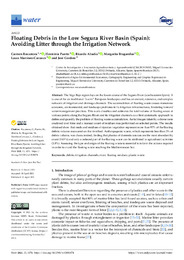Please use this identifier to cite or link to this item:
https://hdl.handle.net/11000/35517Full metadata record
| DC Field | Value | Language |
|---|---|---|
| dc.contributor.author | Rocamora, Carmen | - |
| dc.contributor.author | Puerto Molina, Herminia | - |
| dc.contributor.author | Abadia, Ricardo | - |
| dc.contributor.author | Brugarolas, Margarita | - |
| dc.contributor.author | Martínez-Carrasco, Laura | - |
| dc.contributor.author | cordero gracia, jose | - |
| dc.contributor.other | Departamentos de la UMH::Economía Agroambiental,Ing. Cartográfica y Expresión Gráfica en la Ingeniería | es_ES |
| dc.date.accessioned | 2025-02-03T10:19:48Z | - |
| dc.date.available | 2025-02-03T10:19:48Z | - |
| dc.date.created | 2021-04-10 | - |
| dc.identifier.citation | Water 2021, 13(8), 1074 | es_ES |
| dc.identifier.issn | 2073-4441 | - |
| dc.identifier.uri | https://hdl.handle.net/11000/35517 | - |
| dc.description.abstract | The Vega Baja region lays on the lower course of the Segura River (southeastern Spain). It is one of the six traditional “huerta” European landscapes and has an ancient, extensive, and complex network of irrigation and drainage channels. The accumulation of floating waste causes numerous economic, environmental, and landscape problems in its irrigation infrastructures, hindering farmers’ water management practices. This work classifies and estimates the total volume of floating waste at various points along the Segura River and its irrigation channels as a first systematic approach to define and quantify the problem of floating waste accumulation. Aerial images taken by a drone were analyzed over time and a manual count of residues was performed on selected points. The results obtained show that reeds and residues of riparian vegetation represent more than 95% of the floating debris volume measured on the riverbed. Anthropogenic waste, which represents less than 5% of debris volume, was characterized, finding that plastics of domestic sources are the most abundant by count (14.9%) and only a reduced part of the floating waste can be attributed to agricultural activities (3.8%). Assessing the type and origin of the floating waste is essential to inform the actions required in order to avoid the floating waste reaching the Mediterranean Sea | es_ES |
| dc.format | application/pdf | es_ES |
| dc.format.extent | 18 | es_ES |
| dc.language.iso | eng | es_ES |
| dc.publisher | MDPI | es_ES |
| dc.rights | info:eu-repo/semantics/openAccess | es_ES |
| dc.rights | Attribution-NonCommercial-NoDerivatives 4.0 Internacional | * |
| dc.rights.uri | http://creativecommons.org/licenses/by-nc-nd/4.0/ | * |
| dc.subject | Debris | es_ES |
| dc.subject | Irrigation channels | es_ES |
| dc.subject | River | es_ES |
| dc.subject | Floating residues | es_ES |
| dc.subject | Plastic waste | es_ES |
| dc.title | Floating Debris in the Low Segura River Basin (Spain): Avoiding Litter through the Irrigation Network | es_ES |
| dc.type | info:eu-repo/semantics/article | es_ES |
| dc.relation.publisherversion | https://doi.org/10.3390/w13081074 | es_ES |

View/Open:
Floating Debris in the Low Segura River Basin.pdf
6,4 MB
Adobe PDF
Share:
.png)
